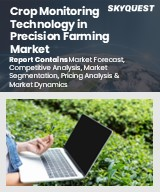
세계의 정밀농업용 작물 모니터링 기술 시장 규모는 2023년에 63억 3,000만 달러로 평가되며, 2024년에는 68억 8,000만 달러, 2032년에는 144억 9,000만 달러로 성장하며, 예측 기간(2025-2032년)의 CAGR은 8.62%로 성장할 것으로 예측됩니다.
세계 정밀농업용 작물 모니터링 기술 시장은 농업 부문이 효율성과 지속가능성을 높이기 위해 디지털 혁신을 점점 더 많이 수용함에 따라 빠르게 진화하고 있습니다. 이러한 변화는 경작지 감소, 기후 변화, 경영비 상승 등의 압력에 대응하고 있습니다. 환경 영향을 최소화하면서 자원 활용을 최적화하려는 정부와 민간단체의 막대한 투자에 힘입어 선진국과 개발도상국 모두에서 정밀농업 기술의 채택이 확대되고 있는 것은 분명합니다. 또한 기후 변화에 대응하는 스마트 농업에 대한 규제 당국의 옹호는 데이터 투명성을 촉진하고, 농가는 작물의 건강 상태를 평가하고 자원을 효과적으로 관리하기 위해 첨단 기술을 활용하게 될 것입니다. 농업의 디지털 전환에 따라 통합 플랫폼과 커넥티드 관리 시스템에 대한 수요가 급증할 것으로 예상되며, 향후 시장의 견고한 성장을 예고하고 있습니다.
Global Crop Monitoring Technology in Precision Farming Market size was valued at USD 6.33 Billion in 2023 poised to grow between USD 6.88 Billion in 2024 to USD 14.49 Billion by 2032, growing at a CAGR of 8.62% in the forecast period (2025-2032).
The market for global crop monitoring technology within precision farming is rapidly evolving as the agriculture sector increasingly embraces digital innovations aimed at enhancing efficiency and sustainability. This shift responds to pressures such as diminishing arable land, climate change, and rising operational costs. Growing adoption of precision farming techniques is evident in both developed and developing nations, spurred by significant investments from governments and private entities seeking to optimize resource usage while minimizing environmental footprints. Additionally, regulatory advocacy for climate-smart agriculture promotes data transparency, prompting farmers to leverage advanced technologies for assessing crop health and managing resources effectively. With the digital transformation of agriculture, demand for integrated platforms and connected management systems is expected to surge, indicating robust market growth ahead.
Top-down and bottom-up approaches were used to estimate and validate the size of the Global Crop Monitoring Technology in Precision Farming market and to estimate the size of various other dependent submarkets. The research methodology used to estimate the market size includes the following details: The key players in the market were identified through secondary research, and their market shares in the respective regions were determined through primary and secondary research. This entire procedure includes the study of the annual and financial reports of the top market players and extensive interviews for key insights from industry leaders such as CEOs, VPs, directors, and marketing executives. All percentage shares split, and breakdowns were determined using secondary sources and verified through Primary sources. All possible parameters that affect the markets covered in this research study have been accounted for, viewed in extensive detail, verified through primary research, and analyzed to get the final quantitative and qualitative data.
Global Crop Monitoring Technology in Precision Farming Market Segments Analysis
The global crop monitoring technology in precision farming market is segmented based on component, technology, application, and region.In terms of component, the market is divided into hardware, software, and services. Based on technology, the market is segmented into remote sensing, variable rate technology, and data management systems. Based on application, the market is categorized into yield monitoring, field mapping, crop scouting, weather tracking & forecasting, soil monitoring, and farm management. Based on region, the market is segmented into North America, Europe, Asia-Pacific, Latin America, and the Middle East and Africa.
Driver of the Global Crop Monitoring Technology in Precision Farming Market
One of the key market drivers for the Global Crop Monitoring Technology in Precision Farming Market is the increasing demand for sustainable agricultural practices. As environmental concerns grow and populations expand, farmers are seeking efficient ways to optimize crop yields while minimizing resource consumption. Advanced crop monitoring technologies, utilizing drones, sensors, and satellite imagery, enable real-time data collection and analysis, allowing farmers to make informed decisions about irrigation, fertilization, and pest management. This not only enhances productivity but also reduces environmental impact, making precision farming solutions essential in meeting the global food demand while addressing sustainability challenges.
Restraints in the Global Crop Monitoring Technology in Precision Farming Market
One key market restraint for the global crop monitoring technology in precision farming is the high initial investment cost associated with advanced technological systems and equipment. Many farmers, particularly those operating on a small scale, may find the financial barrier prohibitive, leading to hesitancy in adopting precision farming solutions. Additionally, the complexity of integrating new technologies into existing agricultural practices can deter potential users. Furthermore, the lack of robust agricultural infrastructure and limited access to reliable internet connectivity in rural areas can hinder the effective deployment and utilization of crop monitoring technologies, limiting their overall market growth.
Market Trends of the Global Crop Monitoring Technology in Precision Farming Market
The market for Global Crop Monitoring Technology within Precision Farming is witnessing a significant uptrend, driven by the integration of artificial intelligence and advanced imaging technologies, including multispectral and hyperspectral systems. These innovative tools enable farmers to engage in proactive and predictive management practices, facilitating the early identification of crop stress, diseases, and nutrient deficiencies. As a result, agricultural stakeholders are increasingly leveraging these technologies to enhance yield optimization and optimize resource inputs. This convergence of AI-driven analytics with sophisticated imaging is set to revolutionize crop monitoring, leading to more sustainable and efficient farming practices across diverse agricultural landscapes.